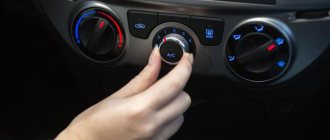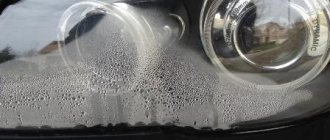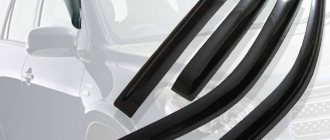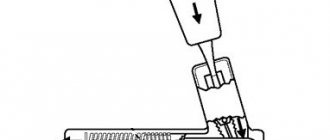During the operation of the car, the driver may encounter various inconveniences. At the same time, the real problem is those that affect not only comfort, but also safety. In practice, in some cases, the headlights may be too weak even after replacing the bulbs, which makes driving at night very difficult. In such a situation, you can solve the problem by polishing the headlights or replacing them.
In other cases, the driver is faced with the fact that the car windows fog up heavily, and this does not always happen only in rain or wet weather. One way or another, foggy glass affects visibility and impairs visibility, leads to stress and fatigue while driving, and also significantly reduces overall safety.
At the same time, not everyone knows why car windows sweat. Next, we will look at the reasons for fogging of windows in a car, when fogged glass indicates possible malfunctions of the car, and also what to do if the windows in the car are sweating.
Causes of condensation
Windows that are wet from the inside mean that while the vehicle is moving, the driver must often be distracted to wipe the glass. This is not only inconvenient, but also unsafe.
Fogging can be caused by one of the following reasons:
Significant difference between air temperatures outside and inside the car. This is typical for the cold season or during a sudden cold snap.- Rain or snow. Precipitation on the street significantly contributes to the increase in humidity in the car itself.
- The car just came out of the car wash. If after treatment the interior has not been properly dried, condensation will appear on the glass.
- Radiator malfunction. Status check and troubleshooting required.
- Air conditioning malfunction. For example, filter contamination.
- Irregularities in the operation of the split system or, alternatively, the need to configure it correctly.
In addition to obvious reasons, increased humidity in the cabin is caused by passengers in the car being intoxicated. The alcohol vapor they exhale settles on surfaces, forming condensation.
Old cabin filter
Another reason for glass fogging is contamination or poor functioning of the filter in the car interior. When the car is actively used in the city or on roads with increased pollution, the interior filter quickly becomes clogged with dirt and becomes unusable.
It also happens that they simply forgot to change this filter during scheduled maintenance.
To fix this problem, you need to replace the cabin filter.
IMPORTANT! For different car models, the cabin filter is located in different places, so information about it should be found in the technical documentation for the vehicle. It also states how often it needs to be replaced.
Treat glass with special products
There are a lot of different anti-fog agents on the market - liquids, aerosols, wipes. This car cosmetics has the same principle - the properties of surface tension change. The solutions create a thin film from which the smallest particles of water roll off, forming drops that do not interfere with the view, or, conversely, the water remains on the glass, but lies in a transparent layer. Apply the product to clean and dry surfaces and repeat the procedure as necessary. You just need to find a drug that suits you in terms of application method, smell and results.
Auto chemicals: how to use correctly
Store-bought anti-foggers are auto chemical items. Almost all of them are made on the basis of technical alcohol, to which chemical components are added - flavorings, thickeners, preservatives. For the auto chemicals to work effectively, the following rules must be observed.
- The anti-fog agent should be sprayed or applied to clean, washed and dried glass. Definitely dry.
- Can be applied in two or more layers, several times. This will increase the operating time of the product.
- Renew the substance in a timely manner, apply the solution or aerosol anew every 2 weeks.
How to remove fogged windows in a car?
There are various methods to combat fogging of car windows.
There are general rules for eliminating condensation:
- Adjusting the air conditioning system. It is necessary to ensure that the windows are constantly blown with warm air.
- Installation of several high-quality moisture absorbers in the cabin. Sorbents effectively absorb water from the space, drying it to the required condition.
- Treatment of glass with special agents that have hydrophobic properties. Even water molecules do not linger on them. Such products are produced in the form of aerosols, liquids and impregnated wipes.
- Opening windows a few millimeters. The resulting air circulation ensures the evaporation of condensation from all surfaces.
- Ventilation (air ventilation) and preventive drying of the interior. This helps to dry the upholstery of chairs, rugs and remove liquid accumulated in the niches.
- Regular vehicle maintenance. Timely replacement of filters, sensors and valves will prevent excess moisture.
In the rain
When it rains, water penetrates into the interior of the car, which, when heated, turns into steam, settling on windows, metal and plastic in the form of tiny drops.
You can get rid of glass fogging in inclement weather in the following ways:
- After starting to drive, open the windows on both sides of the car. The resulting turbulence will ensure condensation is blown off the panels.
- After finishing the trip, park the car in a heated garage. If possible, leave windows and doors open to dry out the cabin.
- Before planting, shake off snow and water from clothes and shoes, pack wet umbrellas in plastic bags or covers.
- Before the onset of the wet season, warm up the interior with a hairdryer to remove moisture from the upholstery. When damp air penetrates, the fabric plays the role of a sorbent.
During the winter season
During the cold season, the formation of condensation complicates the already difficult road situation. In addition, there is a risk of sweat freezing and ice crusts forming on the windows.
What you can do:
- Set the maximum heating temperature by directing the air flow to the front panel. Heat in the cab can be eliminated by opening the side windows.
- Use special preparations against condensation formation. Modern anti-fogging solutions for car windows allow you to get rid of this phenomenon without excessive heating of the interior.
- Install electrically heated panels. This will require additional costs, but they are offset by the comfort and safety of travel.
Ways to fight
Now we should talk about how to effectively deal with fogging of windows in a car and what methods can help.
First, find out the root cause. Given their relatively small list, finding the source of the problems will not be so difficult.
Most often, vehicle windows sweat in winter. Moreover, this applies to any car, from old domestic models to new modern foreign cars. It is optimal to initially take a car equipped with a heated glass function. This functionality will help speed up drying and also prevent active fogging while driving. A similar system is installed on almost all new cars, even in the budget category.
You should also periodically check the functionality of the stove and the heating and air conditioning system fan itself during the winter season. To quickly remove the formed condensation, it is better to turn on the stove and ventilation at the same time. When just the stove is working, it actually circulates the heated cabin air in a circle, but does not let fresh outside air inside the car.
You can give several recommendations on what to do when the windows in your car are actively sweating. All methods and methods are divided into several categories. You can solve the problem using:
- climatic equipment;
- cabin filter;
- special films;
- special anti-fogging agents;
- folk method.
Each method and method should be considered separately. You should not ignore even folk remedies, which have proven themselves well in situations where the inside of the car is actively sweating from the inside of the glass.
Folk recipe
If you want to save as much as possible and you have the necessary components to prepare a product with which it is quite possible to get rid of fogged windows in your own car, you should try this recipe.
The essence of the folk method is to prepare an analogue of professional auto chemical products. The product will consist of denatured or regular ethyl alcohol, as well as glycerin. The proportions are 20 to 1. That is, for 20 parts of alcohol as a liquid component, there is 1 part of glycerin.
It turns out to be a very effective anti-fog. The components are mixed until a homogeneous liquid is obtained. Then the composition is poured into a spray bottle, which you use to wash windows at home or water flowers and apply it to the glass. All that remains is to rub the product with a rag until it dries completely. When the alcohol evaporates, only a thin glycerin film remains. Since the treatment is carried out from the inside, the effect lasts for a fairly long period.
Use of climate control equipment
This method, like the previous one, does not allow you to get rid of the root cause due to which the car windows actively sweat in winter or in the rain. You need to look for the reason yourself.
If it is not possible to completely eradicate it here and now, then just use air conditioning. This is an extremely simple and fast method. It is enough to turn on the interior cooling system and direct the deflectors towards those windows that sweat. The air conditioner is characterized by the fact that it actively dries the air and removes excess moisture.
As practice shows, the air conditioner does an excellent job of defogging the windshield and also partially eliminates condensation from the side windows. But in order to completely get rid of fogging on all windows, you will have to spend more time. And if the problem occurs in winter, when it is already quite cold, it will not be possible to run the interior cooling system for a long time.
This is a good temporary and quickly implemented measure to clear the windshield and provide the driver with a good view. But it would still be better if you find the source of the problem and, if possible, eliminate it.
Replacing the cabin filter
This is one of the most common reasons why the interior windows of a car still sweat at any time of the year and in different weather conditions.
Cabin filters
It also happens that turning on the heating or air conditioning still does not give any effect, and the windows continue to be covered with a layer of condensation. Then the first thing you should think about is how long ago you changed the cabin filter. There is a high probability that the reason lies precisely there.
When the cabin filter becomes dirty, it loses its capacity. Thus, the filter does not allow excess moisture to be removed from the cabin along with the air. She has no choice but to settle on the internal surfaces. The driver and passengers notice this precisely by the fogged windows.
In the vast majority of cases, there is nothing difficult about replacing the cabin filter yourself. But different machines use the corresponding location of this element. On modern cars, filters are usually placed in a special box behind the glove compartment. The easiest way is to look at the instruction manual, understand where the consumable is located, and change it.
When replacing, be sure to blow out the seat under the filter. It would also be a good idea to combine replacing the cabin filter with cleaning the air conditioner evaporator.
Protective films
Since under certain weather conditions accompanied by high humidity, the windows will still fog up, the use of special films can be considered.
The principle of their application and use is extremely simple. Anti-fog films are applied in almost the same way as films for tinting car windows.
Before application, the surface must be thoroughly cleaned, degreased and dried. Then the material is carefully glued, which creates an anti-fogging effect.
It is only recommended to buy the highest quality films. At the same time, try to avoid excessive contamination of the cabin filter and adhere to the basic rules for preventing fogging of car windows. In this combination, the film will really work for a long time and effectively.
Professional auto chemical goods
If you go to an automotive chemical store, you will probably see a whole scattering of all kinds of products, the main task of which is to resist the formation of water droplets in the form of condensation and evaporation on the glass surfaces of the vehicle.
Usually such drugs are called anti-rain or anti-condensate, or simply anti-fog. The essence does not change from the name. The essence of using such auto chemicals is to create a protective coating on the surface that prevents moisture from accumulating. Moreover, anti-rain or anti-condensation can be used outside and inside.
Read the manufacturer's instructions carefully. There is a category of auto chemicals that is used strictly for external treatment. This is due to their chemical composition, which has an aggressive effect on humans. But there are also a large number of universal products that do an excellent job of combating fogging inside and outside.
This category of products comes in 2 types depending on consistency.
- Liquids. In most cases, liquid anti-rain is sold in special containers equipped with a sprayer or spray bottle. With their help, the composition is easily applied to the glass surface for subsequent rubbing. When choosing a liquid anti-rain, be sure to take into account the features of its operation. There are sprayers that help repel moisture. They effectively cope with their tasks, but are suitable for outdoor treatment where drops of rain or snow fall. For internal treatment on the interior side, it is better to take anti-rain, the property of which is to prevent the formation of moisture. The liquid is applied to clean and dry glass, after which it is rubbed with rags or napkins that do not leave lint behind. This forms a transparent protective film on the surface that resists the formation and accumulation of moisture.
- Mastics. If you want to get a longer-lasting effect and are willing to spend more money on it, then it makes sense to purchase an anti-fog in the form of a mastic. This is a concentrated product, the structure of which is more like a paste or gel than a liquid for spraying. Apply in the same way as liquid. That is, the glass needs to be cleaned and dried. Next, the mastic is distributed over the entire surface in an even layer and rubbed until the glass shines.
The advantage of gels and mastics is that they often combine two properties at once. Namely, they repel water and prevent the formation of moisture on glass surfaces.
After applying the mastic, a transparent layer of film also remains. Only the thickness is noticeably different from ordinary liquid. Because of this, the duration of operation of the anti-fogger is longer.
Auto glass defoggers
The use of anti-fog chemicals
These days, specialized supermarkets and stores offer a wide range of chemicals that, according to manufacturers, can save you from problems with windows fogging up inside your vehicle.
The degree of their effectiveness varies greatly, so before purchasing it is better to study reviews of the proposed product. A number of criteria that should be followed when choosing a chemical:
- Before starting work, study the principle of operation of the chemical;
- look at the reviews to choose the most suitable and high-quality product;
- evaluate the principle of operation and the need to use other tools;
- choose the scent that suits you best, because... it will remain after the work is completed;
- Please read the attached instructions carefully.
Like any other chemical, it is applied to a clean and dry car glass. You should not immediately use a chemical after thoroughly cleaning the glass.
There is a possibility that after proper cleaning the glass will stop fogging up. Pollution as a cause of fogging is not uncommon.
Making your own product
Despite the wide range of auto chemicals on store shelves, some car enthusiasts prefer to make anti-moisture compounds on glass themselves.
You can make your own glass defogger from the following available substances:
- Glycerol. It can be used without additives. Simply wipe the glass with a piece of cloth and wipe dry.
- Glycerin and alcohol. Take in a ratio of 1:2 and mix until a homogeneous solution is obtained. Then they wipe the glass with it.
- Vinegar and essential oils. Ingredients: water (250 ml), vinegar (30 ml), any essential oil (10 drops). The water is brought to boiling point, removed from the heat and vinegar and oil are poured into it. Then mix thoroughly. Apply the cooled solution to the glass using a spray bottle. This remedy is very effective. Once applied, it can last up to a month.
The choice of essential oil depends on the preferences of the car enthusiast - what smell he prefers to feel in his car.
How to prevent your windows from fogging up
- Remove moisture from rubber troughs on the floor.
This can be done with a rag, newspaper or a regular snowball - place it on the floor and the snow will absorb the moisture. - special car diapers
on sale . According to the results of our tests, this mat holds up to 300 ml of water. - In general, you can reduce the humidity in the cabin using a dehumidifier
. Silica gel or regular cat litter will do the job. Fill an old sock with granules and place it on the floor of the car - the air humidity will decrease.
Old cabin filter
Another reason for glass fogging is contamination or poor functioning of the filter in the car interior. When the car is actively used in the city or on roads with increased pollution, the interior filter quickly becomes clogged with dirt and becomes unusable.
It also happens that they simply forgot to change this filter during scheduled maintenance.
To fix this problem, you need to replace the cabin filter.
IMPORTANT! For different car models, the cabin filter is located in different places, so information about it should be found in the technical documentation for the vehicle. It also states how often it needs to be replaced.
If the windows are already fogged up
- The simplest thing is to wipe the foggy windows with newspaper
. This is better than using a rag, because printing ink leaves a thin film on the glass, which prevents the glass from fogging up in the future. - Rub shaving foam or toothpaste over the glass
, which, among other things, provides a cleaning and polishing effect. The advice to wipe the glass with a bag of salt is definitely harmful: salt and a car are incompatible things. But you can use car shampoo or a bar of soap.
special automotive anti-fog agents for preventative purposes.
. This is the best way. Just remember that these products need to be used on dry, clean glass. If it has already fogged up, it is too late to apply the drug.
How to properly clean foggy glass
Many novice motorists simply do not know how to properly use the means at hand and the systems available in the car to get rid of fog on the windows.
Therefore, we suggest you study 5 simple recommendations that will help you cope with such a situation.
- To clean the side windows and windshield, you first need to turn on the interior heating system. Then the warm air flows need to be directed towards the problem area. Just don't turn the temperature up to maximum. Just slightly warm air is enough. If you turn on maximum heating, then due to the large difference between the air temperature inside and outside, a crack may form on the glass.
- If it is raining outside, then a more effective way to remove condensation will be to supply barely warm or even cold air. The temperature in such a situation will not affect the speed and quality of drying the surface from moisture.
- To prevent the rear window from fogging up, which also plays an important role in safe driving, turn on the rear window defroster as soon as you start the engine.
- You can simply clean windows with dry rags, napkins or other materials that do not leave lint behind. Moreover, it is better to do this when only the driver or a minimum number of passengers are inside the cabin. The air contains a lot of moisture, which is why when you exhale, your efforts may be in vain. First, it is better to remove excess moisture, then turn on the airflow, and then invite passengers into the cabin.
- If your machine is equipped with an air recirculation function, use it while driving. This allows you to act in the future, preventing fogging of the glass.
To summarize, we can say with confidence that the problem of window fogging occurs on absolutely all cars. Yes, some machines are equipped with special systems that operate automatically and almost prevent moisture from appearing on the outer and inner surfaces of the glass. But not everyone has such solutions.
The simplest way out of the situation would be to prevent fogging by following the previously announced rules and recommendations. First you need to understand the reason, and starting from it, correct the situation.
METHODS OF CLEANING GLASS FROM FOGING
No matter how modern and well-maintained a car is, sooner or later the windows will still fog up. This is a natural process, especially when there is a high level of humidity outside.
Here's what you can do to quickly remove steam from your windows.
- Rear window. To clean it, while the engine is warming up, you must immediately turn on the heated rear window. It will dry in just a couple of minutes while the car is parked.
- Side windows. To clean, just lower them and raise them. Window seals will do the trick.
- Windshield. While the car is parked, you need to turn on the air conditioning. This device not only cools the air, but removes excess moisture from it. There is no point in turning on the heating when the engine is cold, since the stove heats the air due to the temperature of the heating radiator. It, in turn, is heated by the engine coolant.
If the car is not equipped with air conditioning, heated rear window and electric windows, simple improvised means will come to the rescue. The driver can use regular paper kitchen towels. They absorb moisture well and are inexpensive.
In rainy times, windows may fog up while the car is moving. To fix the problem, just open the side window a little. This will allow moisture to leave the cabin and provide fresh air.
Some people use anti-fog devices that prevent condensation from forming on the glass.
And the most important! Do not wipe foggy windows while driving. By being distracted from driving (even for a couple of seconds), the driver puts both himself and his passengers at risk.
Rain is no problem
In rainy weather, wet windows interfere with visibility, and anti-rain preparations will help us here. The principle of their operation is based on the so-called hydrophilic effect, when the glass is covered with a thin film that does not allow water molecules to “stick” and spread into a wet layer. As a result, water collects on the surface in the form of balls, which do not interfere much with the view, and are also easily brushed off by the oncoming air flow.
Anti-rain preparations are available in different types and packaging: sprays, gels, sponges and napkins soaked in the composition. The latter often offer a compromise solution - the product is quickly and conveniently applied, but the water-repellent film is short-lived and requires constant updating. With sprays, and especially gels, sometimes you have to tinker, even to the point of using a polishing machine or a drill attachment, but the resulting film can last up to a month or two and survive a couple of washes. It is important to remember that these compounds are applied exclusively to clean glass.
It is recommended to use “anti-rain” on surfaces that are inaccessible to wipers and washers - mainly side windows and external mirrors. But whether it is worth applying it to the windshield is a controversial issue. Many compositions, at a certain incidence of light rays, produce a rainbow effect - although beautiful, it makes it difficult to see. In addition, the composition comes into conflict with the washer fluid, which, like all detergents, has the opposite hydrophilic effect, that is, it intensively wets the surface. On the other hand, less dirt settles on a smooth, treated surface, so there’s not much work to do to “wash.” A compromise option can be considered the treatment of areas inaccessible to wipers, for example, near glass pillars. But personally, I think that it is better to use a special polish for the windshield, and this is a topic for the next chapter.
To keep the glass from freezing
It helps to cover the inside of the glass with a transparent film. The thermal conductivity of the film is much lower than that of glass, and such a “glazed window” will no longer freeze.
To prevent beautiful frosty patterns from forming on the windows overnight, do not forget to ventilate the interior before leaving the car in the parking lot. To do this, open the windows slightly during the last hundred meters of the journey, and after parking, open all the doors for a few minutes. The temperature of the glass outside and inside will be equalized, because you will release all the warm air from the cabin.
I wish that the windows of your car always remain crystal clear.
- Find out how to set up a ventilation system to prevent windows from sweating here.
- The warm-up time for the interior will be significantly reduced if you cover the engine with a special blanket. To avoid icing on your wipers, install heated blades: various connection options, discounts for a set.
Did you like this post? Subscribe and you will always be in the know!
Driving on Yandex.Zen
Damage and chances of repair
Now about the types of damage themselves and how great are the chances of minimizing the consequences. Small crater marks are considered not chips, but cuts; they do not grow further, and there is no need to repair them.
A similar type of deeper damage, called a bull's eye, will also not spread further if there are no microcracks. But in any case it must be repaired, otherwise in the future under the influence of external factors it can lead to further damage.
The situation is worse with cracks, which can be single or combined, and the most difficult case is an “asterisk”, from which many rays diverge, each of which can turn into a crack. It is in this case that it is important to carry out repairs as quickly as possible. But it is not always effective, and sometimes it is simply not economically feasible if the cracks are already large (more than 10 cm in length) and there are many of them. In general, it all depends on the damage itself, its extent, as well as on the condition of the glass itself and the cost of replacing it.
There may also be a combination of a “bull’s eye” and a “star”, from which the rays diverge. In this case, it is also important to make repairs as quickly as possible.
Only triplex can be repaired, and only on the condition that only the top layer is damaged. If the impact reaches the inside, the glass requires replacement. The expediency and chances of success of the repair are assessed by the master. If the damage is minimal, the repairs were carried out promptly and in compliance with the technology, you can count on the glass still serving.
At the same time, heating is worth mentioning separately. Firstly, you should not use it from the moment the glass is damaged until repair. By the way, according to some craftsmen, even after repairs, the use of heating increases the risk of growth of “healed” cracks, but there are other opinions on this matter. Also, let's not forget that during the repair process, cracks are drilled, and the conductive thread may be damaged - heating will not work in this area. On the other hand, if the damaged area is not repaired, then later you still risk having to replace the glass.
By the way, it is believed that the lower part of the glass is subject to greater temperature changes than the upper: here you have both an air supply from the climate system and heating filaments (if only partial heating is used in the resting zone of the brushes). Accordingly, the “healed” places located above have a better chance.
Prevention of glass fogging
To avoid condensation, you should follow a few simple rules:
- Before boarding the cabin in conditions of heavy rainfall, place pieces of cellophane, old linoleum or unnecessary rags on top of the mats. They will collect water from the shoes, which can then be easily removed from the interior.
- Before a long trip, pre-rub the glass with mastic, glycerin or another long-acting product. Always have a supply of anti-icing and de-icing agents on your windows.
- Periodically dry upholstery and rugs. Dry things can act as a sorbent for a long time.
These methods will reduce the humidity in the cabin and reduce the likelihood of windows fogging in any weather conditions.
Moisture in the cabin: what to do?
If there is chronic humidity inside the car, it is worth checking the condition of the underbody and raising the rugs. If it is humid under them, the tendency to fog will be increased. What should I do?
- Dry the upholstery under the rugs.
- Place a porous absorbent substance under the driver or passenger seats. Cat litter is often used. Salt also works. It absorbs not only moisture, but also unpleasant odors.
- Check the condition of the seals and, if necessary, change them so that rainwater does not enter the car interior.
- Check the serviceability of the engine cooling system - it can also be a source of moisture for the interior space.
Be sure to read the article about which car lock defroster to buy or how to make it yourself.
Find out what benefits a heated windshield gives a driver and how to install this function correctly in our article.
For more detailed information about the windshield washer, its features and selection rules, read the material from our expert.
To be fair, it is worth noting that on many modern cars the windows do not sweat. Their hood and glass blowing work quite well. Therefore, there are no conditions for condensation to form on the glass. The issue of fogging is more relevant to cars of the domestic auto industry with insufficient ventilation and clogged filters, with a faulty heating system on the rear window. Thus, the question of an anti-fog arises.











